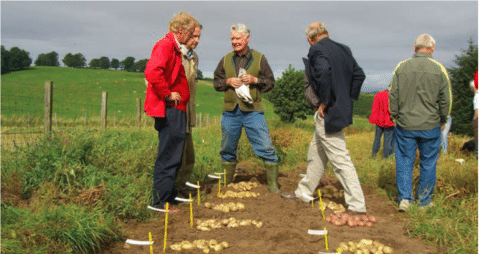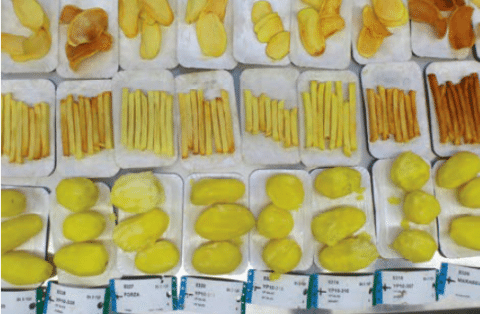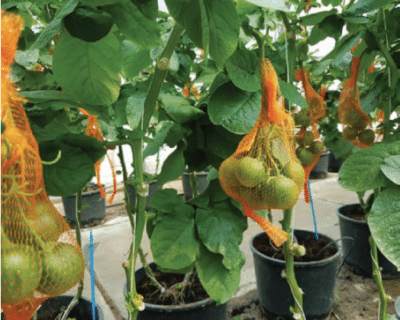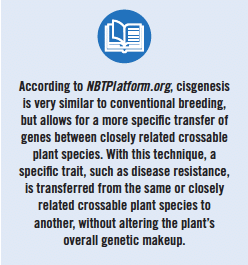[deck]Marcel Bruins, editor of European Seed, discusses the challenges and opportunities of breeding new potato varieties with the leaders of Europe’s major potato breeding companies.[/deck]
Of the top 10 food crops in the world, potato comes third, and is the No. 1 non-grain food product. Originally grown in the Andes, the Spanish introduced the potato to Europe in the 16th century, and, after a bumpy start, potatoes have been a very popular food source over the past two centuries.
The potato is a healthy, low-calorie, high-fibre food that offers significant protection from cardiovascular disease and cancer. Additionally, potato tubers are a good source of vitamin B6, potassium, copper, vitamin C, manganese, phosphorus, niacin, dietary fibre, and pantothenic acid. They also contain a variety of phytonutrients which have antioxidant activity. No wonder the potato is such a beloved crop across the globe.
Marcel Bruins, editor of our sister publication European Seed, sat down with the leaders of five major potato breeding companies in Europe to learn more about the challenges and opportunities of breeding new potato varieties. Piet Smeenge, director of Kweekbedrijf Smeenge-Research; Vanessa Prigge, Crop Improvement project manager at Solana; Gerard Backx, CEO of HZPC; Jan-Paul Bandsma, product manager at de Nijs Potatoes; and Guus Heselmans, R&D manager of C. Meijer B.V., provided insight on this favoured crop.
Potato Breeding: In It For the Long Run
Potato breeding takes a lot of time, says Smeenge, as only one selection per year can be made. In total, it takes 10 – 12 years before protection and listing. However, European companies are working on ways to shorten that time frame. “In potato, hybrid breeding is still not possible, however, KWS, Solynta, HZPC and Bejo are working on it. So maybe it will be possible in the coming 10 years.”
The multiplication rate of a vegetatively propagated crop is much slower when compared with other seed crops, making the selection process slower and the introduction phase longer. “Hence, many more years are required,” says Backx. Also, in general, vegetatively propagated crops have a more complex genome, which is the biggest hurdle.
“Potato is tetraploid and enormously heterogeneous. Working with diploid plants is possible, but so far this is only done in the research phase. Apart from that, double haploids might be an option, but not an easy route.”
Bandsma agrees. “When you have a good variety produced by vegetative methods, you know what kind of variety you will get after multiplication [always the same]. Although potatoes are multiplied vegetatively, it is possible to improve a variety by traditional stem selection. For example, you can improve tuber count, tuber shape or other things.”
The main challenges associated with the vegetative nature of potato production are the low multiplication rate and the high risk of tuber-borne disease transmission.

It easily takes beyond the fourth field year to reliably assess tuber yield performance due to the low multiplication rate of less than 15 tubers per plant, which means the first years are dedicated to tuber production for testing purposes, says Prigge.
“This lengthens the breeding cycle and also impacts the selection decisions: at the time of the first yield trials, and out of necessity due to limited storage capacity for this bulky crop, more than 99 per cent of the original material may already have been discarded based on visually assessable traits such as tuber traits and breeder’s visual preference,” she says.
“In addition, every multiplication cycle bears the risk of infection of tuber-borne diseases, especially viruses, so extensive testing of tuber samples from each selected genotype is performed.”
Another major disadvantage of vegetative propagation is the ease of farm-saved seed, which in some market segments in European countries easily amounts to 50 per cent, while in emerging countries it is not uncommon to observe 90 per cent farm-saved seed without compensation. “Considering revenues from seed sales and royalties are breeders’ main source of income, much is lost that could otherwise be reinvested in R&D activities,” she adds.
European Breeding Goals
The potato market has many sectors, says Backx, which is reflected in breeding programs. For example, potatoes for processing (starch, chips, French fries) require other characteristics than potatoes for fresh consumption. For processing, items like colour, success in processing, efficiency in the factory, taste, length, among others, are important.
“Those words translate into a long list of characteristics one has to search for. Next to that, it’s yield, disease resistance and tolerances, et cetera, for the grower. Can you store and handle the variety or not? Can you harvest the variety mechanically? Can you produce seed potatoes of that variety? All those items are important,” he says.
“On the other hand, for the fresh market, the taste, skin, colour, and appeal are important. The fresh market is very diverse. Different areas have different preferences, and consumers like to have potatoes for firm cooking, or to make mashed potatoes, or homemade French fries. All those uses require other characteristics. Therefore, we clearly define for what markets we like to create varieties, and what selection criteria we need to score. For every sub-segment of the market, it’s a long list of characteristics.”
In short, Prigge says, those characteristics include quality, agronomic performance, and disease resistance. “In reality, there are more than 50 traits our potato breeders take into account during the selection process, which means the selection intensity per trait is quite low.
“We develop improved potato varieties for many potato sectors, mainly the crisp [chip] and French fries industries, the starch industry, and the retail sector, all on a global scale. Hence, next to a set of common goals like early maturity or yield capacity for all segments, there are always additional goals specific to the demands of a certain market segment,” she adds.

According to Heselmans, yield, stability, resilience and quality in-crop and in processing are the most important factors. Then, in many regions, part of the crop has to be stored for a long time. “To have a reliable result for potato crops within the whole chain, it’s a challenge to combine all these factors. Sustainability is the key factor in decision making.”
For Bandsma, the most important goals are underwater weight (high dry matter content), early to medium-early maturity, a strong tolerance against heat and drought, and usefulness for French fries, crisps, export varieties and table potatoes (yellow fleshed). “Potato is attacked by several diseases, such as late blight, common scab, silver scurf and Rhizoctonia, and many others, so we need good resistance against those diseases.”
Smeenge lists yield, consumer acceptance, resistance to diseases, adaptation to different climates and usefulness for table, crisps and French fries as the most important breeding goals for his company.
Genetic Material Acquisition
Where do these companies find the genetic material for important characteristics like disease resistance? Having a stake in a breeding company helps.
“We are shareholders of the breeding company FOBEK, and they are making crosses based on our wishes. They have quite a genetic diversity for resistances. They are getting their genetic diversity from their own seed lines and making their own crosses and backcrosses, as well as cooperation with different companies,” says Bandsma.
“Secondly, we work with free hobby breeders. They also have genetic diversity for the genes. They get their genetics from their own seed lines, making their own crosses, working with other hobby breeders, and trying to get seed lines from potato companies.” Some of his company’s goals are potato cyst nematode, wart disease, common scab and late blight.
For Prigge, the anticipated market determines the relevance of a disease for the company’s potato breeding program. At the moment, varieties with resistance to the white nematode Globodera pallida are in high demand from European farmers, no matter what market segment. New and highly virulent nematode strains have overcome the resistance of popular resistant varieties.
“In this case, we return to the vast collection of potato relatives held in genebank collections to identify genotypes that are resistant to these more virulent G. pallida strains, and try to introgress these loci into our improved breeding populations. We did the same for late blight or root knot nematode resistance because little genetic variation for resistance against these diseases was available in European potato varieties.”
She says with other diseases, such as blackleg, there is hardly any breeding possible because they lack the prerequisites for breeding progress: genetic variation and an efficient and reliable phenotyping system.

Resistance breeding is an important column in the Meijer breeding program, says Heselmans. In areas with intensive cultivation, soil-borne diseases like wart disease and nematodes create huge problems, whereas late blight is an important threat on a global scale. Besides that, for many other diseases like silver scurf, and common scab and virus disease, there is a minimum level of resistance required.
“To retrieve resistance toward diseases into our commercial potato breeding program, Meijer cooperates with universities and genebanks to introgress new resistance genes from wild species. It is of huge importance that genetic diversity is maintained. For this reason, recently a group of Dutch potato breeders decided to actively support the Dutch genebank to maintain and release new material.”
Nematodes, especially the two species G. rostochiensis and G. pallida, are the most important pests to consider, according to Smeenge. He draws his genetic diversity from starch varieties, from the genebank at Wageningen University, and from his own breeding lines.
After that, late blight is next on his list. He says he gets the genetic diversity from the Louis Bolk Institute through the Bio-Impuls Program, and his own breeding material. Third is common scab and virus disease. Here, genetic diversity comes from his own breeding program which has already been in existence for more than 45 years.
When it comes to disease, Backx says the most important ones depend partly on what the variety will be used for and in which area it will be grown. Since late blight is a disease found everywhere, resistance is very important. However, a single resistance is quickly broken. Thus, complex multiple resistances need to be worked on, which is not easy, he says.
“We should not forget that common scab is not an issue for all growers in all areas . Other items like nematode resistance are the most important,” says Backx. He finds genetic diversity for resistances in the genebank, but he also uses other Solanum types and existing varieties. “That is the common way to create genepools,” he says.
According to Backx, resistance can only be effective if it’s a multiple resistance, based on different systems. The fungus is that quick to adapt. Through classic breeding this is hardly possible. With cisgenesis it has been realized.
“Here you get to the question whether a product created through cisgenesis should be allowed on the market. It is considered one of the new breeding technologies. If we could use those techniques, it would help breeders enormously, and with that farmers and the environment. Personally, I would be in favour of allowing a proper cisgenesis product as long as you can prove there is no strange DNA [of a completely other species] in it.”
Meijer supports the position of Plantum — the Dutch association for the plant reproduction material sector — on this subject, which indicates cisgenesis is a new plant breeding method that does not result in foreign DNA in the end product, so no species barriers are crossed and should, according to the Dutch government, not be regulated as GMO, says Heselmans.

Bandsma believes there are sufficient genes against late blight. “The only thing which is very important is we need to stack more genes of late blight into a potato variety or seed line. We think it is possible to achieve a good variety, which is very strong against late blight, without cisgenesis,” he says.
“It will take some time. We know FOBEK has good genetic diversity for late blight genes. We don’t like GMO, but we believe that cisgenesis could be a good addition to potato breeding. Using genes against late blight from another Solanum family could be a good opportunity to solve the problem. On the other hand, how quickly will the late blight fungus be able to adjust or break the resistance?”
Smeenge says cisgenesis is the transplanting of genes within the species Solanum tuberosum. “The benefit of cisgenesis is it can lead to a new variety in a very short time. So, I think it should be released for production and special for further breeding. However, I am against transplantation of genes between different species, for example potato and sugarbeet. I have an ethical problem: we are going to play God.”
Several late blight resistant varieties have been commercialized lately, bred by classical methods of recombination and selection, including their own variety Connect, says Prigge.
“These varieties stem from extensive research and pre-breeding efforts in both the public and private potato sectors aimed at exploiting resistance loci from unadapted Solanum species for introgression breeding programs in potato,” she says.
“Whilst these pre-breeding activities are very time-consuming, sustainable resistance gene stewardship requires stacking of several resistance genes, and that’s where we see the great advantage of new breeding techniques, because with cisgenesis, for example, you can develop stable resistances more efficiently.”
Editor’s Note: Part II will be available in Spud Smart’sWinter 2019 issue. The second part of this feature will examine breeding for abiotic stress tolerance, improved nutrition and health characteristics, additional European breeding targets, access to germplasm, and the new regulations on access and benefit sharing. Also included are where European breeding companies are focusing their development investments, and future products and innovations in the pipeline.










